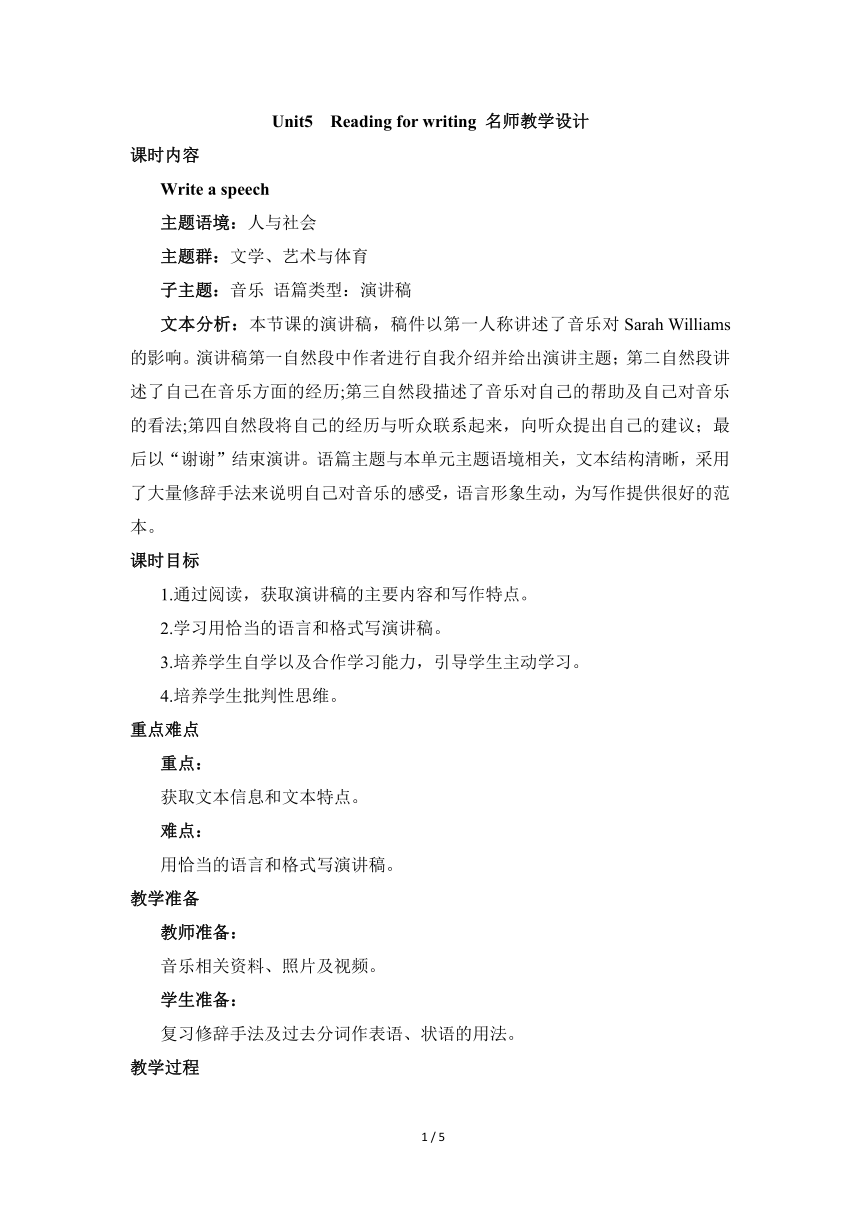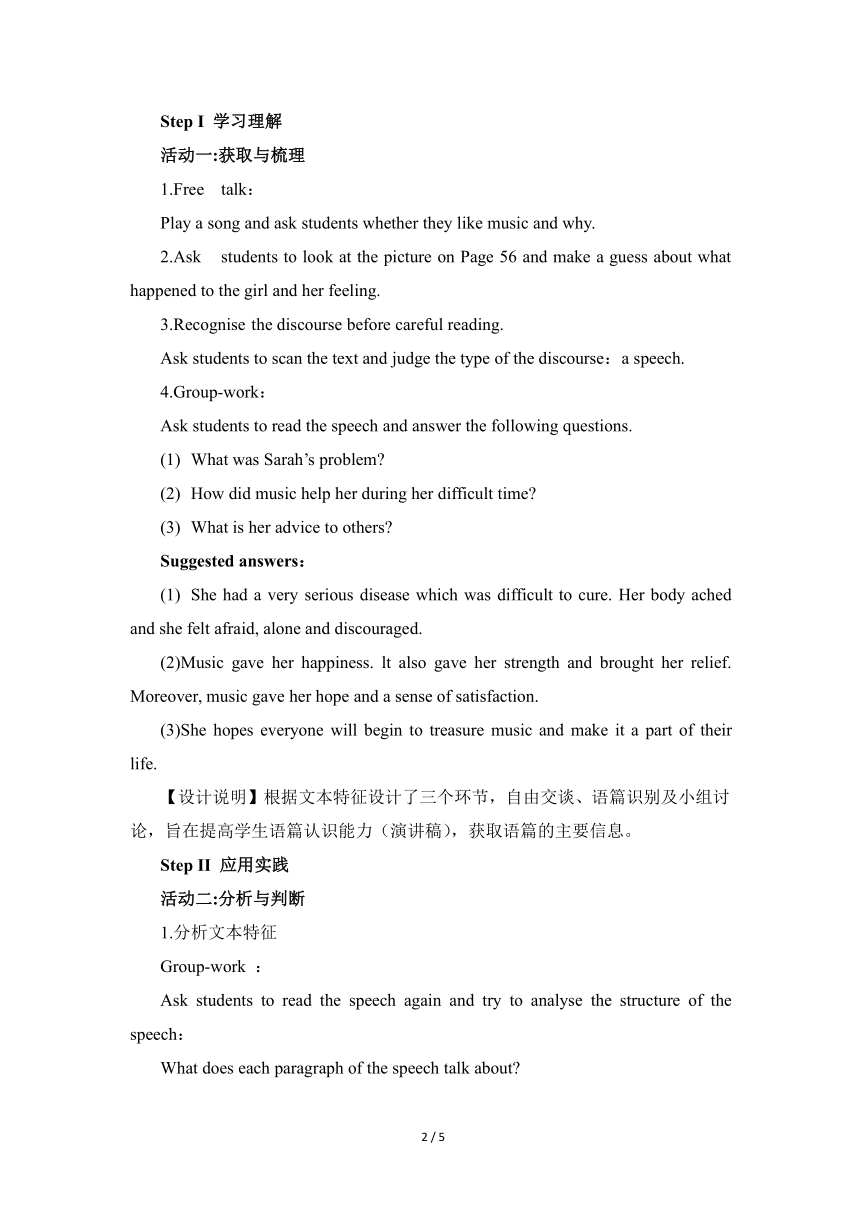人教版(2019)高中英语必修第二册 Unit 5 Music Reading for writing_名师教学设计
文档属性
| 名称 | 人教版(2019)高中英语必修第二册 Unit 5 Music Reading for writing_名师教学设计 |  | |
| 格式 | doc | ||
| 文件大小 | 33.1KB | ||
| 资源类型 | 教案 | ||
| 版本资源 | 人教版(2019) | ||
| 科目 | 英语 | ||
| 更新时间 | 2023-03-10 12:18:50 | ||
图片预览


文档简介
Unit5 Reading for writing 名师教学设计
课时内容
Write a speech
主题语境:人与社会
主题群:文学、艺术与体育
子主题:音乐 语篇类型:演讲稿
文本分析:本节课的演讲稿,稿件以第一人称讲述了音乐对Sarah Williams的影响。演讲稿第一自然段中作者进行自我介绍并给出演讲主题;第二自然段讲述了自己在音乐方面的经历;第三自然段描述了音乐对自己的帮助及自己对音乐的看法;第四自然段将自己的经历与听众联系起来,向听众提出自己的建议;最后以“谢谢”结束演讲。语篇主题与本单元主题语境相关,文本结构清晰,采用了大量修辞手法来说明自己对音乐的感受,语言形象生动,为写作提供很好的范本。
课时目标
1.通过阅读,获取演讲稿的主要内容和写作特点。
2.学习用恰当的语言和格式写演讲稿。
3.培养学生自学以及合作学习能力,引导学生主动学习。
4.培养学生批判性思维。
重点难点
重点:
获取文本信息和文本特点。
难点:
用恰当的语言和格式写演讲稿。
教学准备
教师准备:
音乐相关资料、照片及视频。
学生准备:
复习修辞手法及过去分词作表语、状语的用法。
教学过程
Step I 学习理解
活动一:获取与梳理
1.Free talk:
Play a song and ask students whether they like music and why.
2.Ask students to look at the picture on Page 56 and make a guess about what happened to the girl and her feeling.
3.Recognise the discourse before careful reading.
Ask students to scan the text and judge the type of the discourse:a speech.
4.Group-work:
Ask students to read the speech and answer the following questions.
(1) What was Sarah’s problem
(2) How did music help her during her difficult time
(3) What is her advice to others
Suggested answers:
(1) She had a very serious disease which was difficult to cure. Her body ached and she felt afraid, alone and discouraged.
(2)Music gave her happiness. lt also gave her strength and brought her relief. Moreover, music gave her hope and a sense of satisfaction.
(3)She hopes everyone will begin to treasure music and make it a part of their life.
【设计说明】根据文本特征设计了三个环节,自由交谈、语篇识别及小组讨论,旨在提高学生语篇认识能力(演讲稿),获取语篇的主要信息。
Step II 应用实践
活动二:分析与判断
1.分析文本特征
Group-work :
Ask students to read the speech again and try to analyse the structure of the speech:
What does each paragraph of the speech talk about
Suggested answers :
Paragraph 1:Make a self-introduction and give the topic of the speech.
Paragraph 2: The writer’s experience with music.
Paragraph 3:Her feeling about music.
Paragraph 4: Relate her experience to the audience (give her advice).
Paragraph 5:Close the speech.
2.赏析语言
(1) Ask students to read the text again and match the names of rhetorical devices to the lettered sentences in the speech.
Metaphor: Personification:
Quote: Repetition:
Rhetorical question: Simile:
Suggested answers:
Metaphor:E
Personification :F
Quote:B
Repetition:C
Rhetorical question:A
Simile:D
(2) Question:
What expressions does Sarah use to talk about how music can make us feel Circle the phrases in the speech.
Suggested answers:
Music gives me…,makes my spirit fly, music brings me...,leans on, speaks words of encouragement to...,etc.
【设计说明】活动二分析文本特征和赏析语言特征,深度阅读,挖掘主题意义,学习语篇的写作特征,有助于提高学生对演讲写作的认识和理解,为后续写作做了有效铺垫。
活动三:实战演练
Complete the speech
1.Brainstorm.
Ask students to work in groups of four, and make a list of the ways that people experience music and how music can help people.
Ways people experience music: How music can help people:
singing, give encouragement,
2.Pair-work.
Ask students to talk about their experiences with music and how it has changed their life, or talk about how the life of someone they know has been changed by his/her experience with music.
3.Fill in the blanks below with some of the rhetorical devices you hope to use in your speech.
Metaphor:
Personification:
Quote: said.
Repetition: Music makes/gives/helps me/him/her.
(1) (2) (3)
Rhetorical question:Have you ever
Simile (verb+like):
4.Ask students to write their own speeches according to the structure of the speech and use the rhetorical devices listed above.
【设计说明】本活动为写作实践,在写前设计了头脑风暴活动,学生以小组形式讨论人们体验音乐的方法以及音乐对人们的帮助,然后让学生分享自己在音乐方面的经历以及音乐对自已的影响,最后让学生列出写作中可能用到的修辞手法,降低写作难度,增强写作的信心。
Step III 迁移创新
活动四:批判与评价
1.Exchange drafts in groups of four and assess each other’s work according to the checklist:
(1) Does the writer explain how music has changed his/ her/ someone else’s life
(2) Are some of the rhetorical devices included and used properly
(3)Does the writer talk about how music makes him/ her/someone feel
(4)Is the first word in each sentence capitalised
(5)Does the writer use correct punctuation
2.Learn from each other.
3.Ask each group to recommend a student’s writing. Choose two of the recommendations to share with the class.
【设计说明】该环节通过小组合作,从内容、修辞手法、拼写及标点符号使用等方面,对组内成员的草稿进行综合评价与相互学习,加深对主题意义的理解和多元思维的培养,实现深度学习。
4.课后作业
(1)Polish your writing after class.
(2)Copy the useful expressions in your group members’ writings and try to memorise them.
板书设计
Unit 5 Music
Period V Reading for Writing
I .学习理解
活动一:获取与梳理
II.应用实践
活动二:分析与判断
活动三:实战演练
III.迁移创新
活动四:批判与评价
课时内容
Write a speech
主题语境:人与社会
主题群:文学、艺术与体育
子主题:音乐 语篇类型:演讲稿
文本分析:本节课的演讲稿,稿件以第一人称讲述了音乐对Sarah Williams的影响。演讲稿第一自然段中作者进行自我介绍并给出演讲主题;第二自然段讲述了自己在音乐方面的经历;第三自然段描述了音乐对自己的帮助及自己对音乐的看法;第四自然段将自己的经历与听众联系起来,向听众提出自己的建议;最后以“谢谢”结束演讲。语篇主题与本单元主题语境相关,文本结构清晰,采用了大量修辞手法来说明自己对音乐的感受,语言形象生动,为写作提供很好的范本。
课时目标
1.通过阅读,获取演讲稿的主要内容和写作特点。
2.学习用恰当的语言和格式写演讲稿。
3.培养学生自学以及合作学习能力,引导学生主动学习。
4.培养学生批判性思维。
重点难点
重点:
获取文本信息和文本特点。
难点:
用恰当的语言和格式写演讲稿。
教学准备
教师准备:
音乐相关资料、照片及视频。
学生准备:
复习修辞手法及过去分词作表语、状语的用法。
教学过程
Step I 学习理解
活动一:获取与梳理
1.Free talk:
Play a song and ask students whether they like music and why.
2.Ask students to look at the picture on Page 56 and make a guess about what happened to the girl and her feeling.
3.Recognise the discourse before careful reading.
Ask students to scan the text and judge the type of the discourse:a speech.
4.Group-work:
Ask students to read the speech and answer the following questions.
(1) What was Sarah’s problem
(2) How did music help her during her difficult time
(3) What is her advice to others
Suggested answers:
(1) She had a very serious disease which was difficult to cure. Her body ached and she felt afraid, alone and discouraged.
(2)Music gave her happiness. lt also gave her strength and brought her relief. Moreover, music gave her hope and a sense of satisfaction.
(3)She hopes everyone will begin to treasure music and make it a part of their life.
【设计说明】根据文本特征设计了三个环节,自由交谈、语篇识别及小组讨论,旨在提高学生语篇认识能力(演讲稿),获取语篇的主要信息。
Step II 应用实践
活动二:分析与判断
1.分析文本特征
Group-work :
Ask students to read the speech again and try to analyse the structure of the speech:
What does each paragraph of the speech talk about
Suggested answers :
Paragraph 1:Make a self-introduction and give the topic of the speech.
Paragraph 2: The writer’s experience with music.
Paragraph 3:Her feeling about music.
Paragraph 4: Relate her experience to the audience (give her advice).
Paragraph 5:Close the speech.
2.赏析语言
(1) Ask students to read the text again and match the names of rhetorical devices to the lettered sentences in the speech.
Metaphor: Personification:
Quote: Repetition:
Rhetorical question: Simile:
Suggested answers:
Metaphor:E
Personification :F
Quote:B
Repetition:C
Rhetorical question:A
Simile:D
(2) Question:
What expressions does Sarah use to talk about how music can make us feel Circle the phrases in the speech.
Suggested answers:
Music gives me…,makes my spirit fly, music brings me...,leans on, speaks words of encouragement to...,etc.
【设计说明】活动二分析文本特征和赏析语言特征,深度阅读,挖掘主题意义,学习语篇的写作特征,有助于提高学生对演讲写作的认识和理解,为后续写作做了有效铺垫。
活动三:实战演练
Complete the speech
1.Brainstorm.
Ask students to work in groups of four, and make a list of the ways that people experience music and how music can help people.
Ways people experience music: How music can help people:
singing, give encouragement,
2.Pair-work.
Ask students to talk about their experiences with music and how it has changed their life, or talk about how the life of someone they know has been changed by his/her experience with music.
3.Fill in the blanks below with some of the rhetorical devices you hope to use in your speech.
Metaphor:
Personification:
Quote: said.
Repetition: Music makes/gives/helps me/him/her.
(1) (2) (3)
Rhetorical question:Have you ever
Simile (verb+like):
4.Ask students to write their own speeches according to the structure of the speech and use the rhetorical devices listed above.
【设计说明】本活动为写作实践,在写前设计了头脑风暴活动,学生以小组形式讨论人们体验音乐的方法以及音乐对人们的帮助,然后让学生分享自己在音乐方面的经历以及音乐对自已的影响,最后让学生列出写作中可能用到的修辞手法,降低写作难度,增强写作的信心。
Step III 迁移创新
活动四:批判与评价
1.Exchange drafts in groups of four and assess each other’s work according to the checklist:
(1) Does the writer explain how music has changed his/ her/ someone else’s life
(2) Are some of the rhetorical devices included and used properly
(3)Does the writer talk about how music makes him/ her/someone feel
(4)Is the first word in each sentence capitalised
(5)Does the writer use correct punctuation
2.Learn from each other.
3.Ask each group to recommend a student’s writing. Choose two of the recommendations to share with the class.
【设计说明】该环节通过小组合作,从内容、修辞手法、拼写及标点符号使用等方面,对组内成员的草稿进行综合评价与相互学习,加深对主题意义的理解和多元思维的培养,实现深度学习。
4.课后作业
(1)Polish your writing after class.
(2)Copy the useful expressions in your group members’ writings and try to memorise them.
板书设计
Unit 5 Music
Period V Reading for Writing
I .学习理解
活动一:获取与梳理
II.应用实践
活动二:分析与判断
活动三:实战演练
III.迁移创新
活动四:批判与评价
